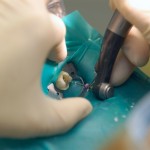
Cleaning the root canal is an important element of root canal treatment and this involves both mechanical instrumentation and chemical irrigation. Sodium hypochlorite is the most widely used irrigant with a range of concentrations (0.5%–5.25%) being reported in the literature although typically a 2.5%. concentration is used. An alternative irrigant is chlorhexidine ( typically 2%) which has broad-spectrum antimicrobial activity and lower toxicity.
The aim of this review was to compare the antimicrobial efficacy of chlorhexidine (CHX) and sodium hypochlorite (NaOCl) in root canal disinfection.
Methods
Searches were conducted in the Medline/PubMed, Embase, Cochrane CENTRAL and Web of Knowledge databases. Randomised controlled trials (RCTs) published in English comparing the antimicrobial effects between CHX and NaOCl reporting bacterial reduction as an outcome were considered.
Two reviewers independently screened the studies, extracted data and assess risk of bias using the Cochrane tool. Dichotomous outcomes were reported as relative risk (RR) with 95% confidence intervals (CI) or as standardized mean difference (SMD) and 95%CI for continuous outcomes. Random effects meta-analyses were conducted.
Results
- 8 RCTs were included but 1 pair of studies was assessed as a single study because it was a continuation.
- Only 1 study was considered to be at low risk of bias, 2 at high risk and 4 at unclear risk.
- Sample collection in all studies used sterile paper points dry or soaked in transporting media.
- 4 studies used culture methods, 3 molecular methods and 1 used both.
- Meta-analysis (6 studies) indicated no difference between NaOCl and CHX in incidence of positive samples, RR= 5 1.003 (95%CI; 0.729 to 1.380).
- Meta-analysis (4 studies) found no difference in bacterial numbers between NaOCl and CHX, SMD = 0.311 (95% CI; -0.368 to 0.991).
Conclusions
The authors concluded: –
Our findings suggest that both CHX and NaOCl can reduce bacterial infections after irrigation without any significant difference in antimicrobial efficacy between them. Although CHX and NaOCl showed similar efficacy, their molecular mechanisms were different. Therefore, they can be used as the main antibacterial root canal irrigants. However, our results were limited by inconsistencies among retrieved articles and a lack of clinically relevant outcomes. Further well-designed clinical studies are warranted to supplement our results.
Comments
The authors have searched a good range of databases although restricting the included studies to those published in English may have excluded some studies. A Cochrane review by Fedorowicz et al regarding root canal irrigants was published in 2012 and we subsequently blogged about another review of this topic in 2016 (Dental Elf 10th Feb– 2016).
This new review aimed to compare microbial activity of NaOCL and CHX and includes 7 studies compared to the 5 included in the 2016 review although only 3 studies are common to both reviews with only 3 of the included studies being published since 2016. The number of teeth included in each study in relatively small ranging from 30 to 60 with only one study including multi-rooted teeth. In addition, only two studies undertook a sample size calculation. The 2012 Cochrane review highlighted the lack of patient relevant outcomes and now of the studies included in this review address patient relevant outcomes either. So, while the review suggests that there is no difference between these two irrigants it is unclear as to whether there are any implications for clinically relevant outcomes.
Links
Primary Paper
Ruksakiet K, Hanák L, Farkas N, et al. Antimicrobial Efficacy of Chlorhexidine and Sodium Hypochlorite in Root Canal Disinfection: A Systematic Review and Meta-analysis of Randomized Controlled Trials. J Endod. 2020;46(8):1032-1041.e7. doi:10.1016/j.joen.2020.05.002
Other references
Fedorowicz Z, Nasser M, Sequeira‐Byron P, de Souza RF, Carter B, Heft M. Irrigants for non‐surgical root canal treatment in mature permanent teeth. Cochrane Database of Systematic Reviews 2012, Issue 9. Art. No.: CD008948. DOI: 10.1002/14651858.CD008948.pub2.
Dental Elf- 10th Feb 2016
Root canal disinfection –sodium hypochlorite or chlorhexidine as an irrigant?
